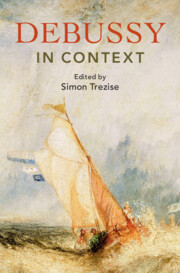Book contents
- Debussy in Context
- Composers in Context
- Debussy in Context
- Copyright page
- Dedication
- Contents
- Illustrations
- Contributors
- Preface
- Notes on the Text
- Abbreviations
- Part I Paris: City, Politics, and Society
- Part II The Arts
- Part III People and Milieu
- Part IV Musical Life: Infrastructure and Earning a Living
- Chapter 18 The Jobbing Composer-Musician
- Chapter 19 Parisian Opera Institutions: A Framework for Creation
- Chapter 20 Société Nationale and Other Institutions
- Chapter 21 Debussy Noctambule and Parisian Popular Culture
- Chapter 22 Music Criticism and Related Writing in Paris
- Part V The Music of Debussy’s Time
- Part VI Performers, Reception, and Posterity
- Recommendations for Further Reading and Research
- Index
Chapter 19 - Parisian Opera Institutions: A Framework for Creation
from Part IV - Musical Life: Infrastructure and Earning a Living
Published online by Cambridge University Press: 23 May 2024
- Debussy in Context
- Composers in Context
- Debussy in Context
- Copyright page
- Dedication
- Contents
- Illustrations
- Contributors
- Preface
- Notes on the Text
- Abbreviations
- Part I Paris: City, Politics, and Society
- Part II The Arts
- Part III People and Milieu
- Part IV Musical Life: Infrastructure and Earning a Living
- Chapter 18 The Jobbing Composer-Musician
- Chapter 19 Parisian Opera Institutions: A Framework for Creation
- Chapter 20 Société Nationale and Other Institutions
- Chapter 21 Debussy Noctambule and Parisian Popular Culture
- Chapter 22 Music Criticism and Related Writing in Paris
- Part V The Music of Debussy’s Time
- Part VI Performers, Reception, and Posterity
- Recommendations for Further Reading and Research
- Index
Summary
In the nineteenth century, French musical activity was mostly structured around opera. It is hard for us to imagine the extraordinary influence it exerted over composers, the press, and consumers of music and performance. It was everywhere, not just in the theatres dedicated to it, but also in concerts and salons, resulting in a truly operatic culture. Piano music, as demonstrated by Liszt, was deeply indebted to opera through reductions, transcriptions, fantasies, variations, and pots-pourris of all sorts. Vocal models also affected the performance and composition of instrumental melodies by many composers. In hyper-centralised France, the heart of this world was Paris in the handful of theatres devoted to opera, which produced most of the original works. The French operatic system functioned with a centre and periphery: there was a producer (the capital) and a multitude of receivers (the provincial towns). This chapter is devoted to Paris’s operatic institutions during Debussy’s lifetime. It broadly considers how they were financed, the ways in which they could make or break composers’ careers, and what was entailed in gaining access to their privileged stages. It also enumerates the differences between the operatic institutions.
- Type
- Chapter
- Information
- Debussy in Context , pp. 177 - 184Publisher: Cambridge University PressPrint publication year: 2024



